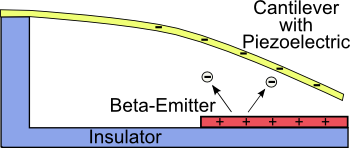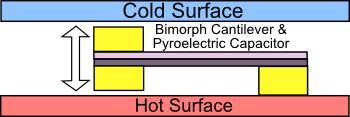Cantilever Energy Harvesting
August 16, 2011
I reviewed the
pyroelectric effect and its application for
energy harvesting in a
previous article (Pyroelectric Energy Harvesting, October 15, 2010). Pyroelectrics have the property that they generate
electricity when they are cycled between
temperatures, such as the
diurnal temperature fluctuations normally present anywhere on
Earth.
One difficulty in harvesting electrical energy this way is that the sign of the
voltage changes depending on whether the material is being heated or cooled, so a
rectifier is required.
To use pyroelectrics when we have a static high temperature source and a static cold temperature sink, we need to employ some mechanical tricks to get a cycling temperature.[1-3] In this case, we use an idea from another unusual energy harvesting technology,
betavoltaics, that I wrote about in a
previous article (Betavoltaic Cells, August 6, 2007).
Beta radiation is the emission of high-energy
electrons when
neutrons decay into
protons. The process is interesting, since it's a natural generator of electrons.
It's possible to use beta decay as an energy source through use of a
cantilever beam to make a
radioisotope piezoelectric generator. Since beta particles are electrons, a cantilever beam can be
charged by a nearby beta radiator. The
isotope,
Nickel-63, can be used in this application. The beta radiator develops an equal and opposite charge, since
charge is conserved in the process by creation of a proton, so the cantilever beam is attracted to it, as shown in the figure.

A radioisotope piezoelectric generator. Charges created by the beta decay draw the cantilever towards the source. When they touch, the cantilever springs back, generating electricity)
When the beam touches the positively-charged radiation source, the charges are neutralized, and the cantilever beam springs back to its original state. The energy from bending can be converted to a voltage by a
piezoelectric material. Such devices have been produced with 7%
efficiency and cycle rate of up to 120
Hz, although a few cycles per minute, or per hour, are more common. The isotope, nickel-63, has a
half-life of more than 100 years, so a very long-lived power source can be made. Beta particles are easier to shield than other forms of radiation, so devices that incorporate beta sources are not particularly dangerous.[4-5]
The same idea of an oscillating cantilever can be used to cycle the temperature of a pyroelectric, and this approach was taken by researchers at
Oak Ridge National Laboratory to harvest energy from waste heat.[6-7]
Thermoelectrics are one method for converting waste heat to electricity, but they are quite inefficient, so new ideas in this area are always welcome. ORNL's principal investigator for the project, Scott Hunter, says that energy-harvesting opportunities for waste heat abound.
"In the United States, more than 50 percent of the energy generated annually from all sources is lost as waste heat, so this actually presents us with a great opportunity to save industry money through increased process efficiencies and reduced fuel costs while reducing greenhouse gas emissions."
The cantilever structure being developed by Hunter and his colleagues, as shown in the figure, uses a
bimetallic strip like those used in some
thermostats. When the cantilever is in contact with a hot surface,
thermal conductivity heats the pyroelectric, but it also causes the bimetallic strip to bend and contact the cold surface. The pyroelectric is cooled, and the bimetallic strip moves again to contact the hot surface. The pyroelectric generates electricity through this hot-cold cycling, and the cantilever will oscillate as long as a temperature differential is present.

ORNL pyroelectric waste heat energy harvester)
The ORNL devices are
MEMS structures that are about a
millimeter square, so a thousand can be fabricated in a
square inch. Pyroelectric energy harvesting has been pursued for decades, but efficiencies of only a few percent have been obtained. The ORNL team, however, projects 10-30 percent efficiency for their MEMS cantilever devices, depending on the temperature of the waste heat source. This type of device is adaptable to environments for which the temperature differential is just a few degrees to several hundred degrees.
References:
- James E. Drummond, "Dielectric Thermal Power Converter," US Patent No. 4,220,906 (September 2, 1980).
- Randall B. Olsen, "Pyroelectric Energy Converter And Method," US Patent No. 4,647,836 (March 3, 1987).
- Yan R. Kucherov, "Piezo-Pyroelectric Energy Converter And Method," US Patent No. 5,644,184 (July 1, 1997).
- Bill Steele, "Tiny atomic battery developed at Cornell could run for decades unattended, powering sensors or machines," Cornell University Press Release, October 16, 2002.
- Mark Paulson, "Nano-Nuclear Batteries".
- Ron Walli, "ORNL energy harvesters transform waste into electricity," DOE/Oak Ridge National Laboratory Press Release, May 16, 2011.
- MEMS-Based Pyroelectric Thermal Energy Scavenger, Oak Ridge National Laboratory, October 1, 2010.
Permanent Link to this article
Linked Keywords: Pyroelectricity; pyroelectric effect; energy harvesting; electricity; temperatures; diurnal temperature fluctuation; Earth; voltage; rectifier; betavoltaic; beta radiation; electron; neutron; proton; cantilever beam; radioisotope piezoelectric generator; charge; isotope; Nickel-63; charge conservation; piezoelectric; efficiency; Hertz; Hz; half-life; Oak Ridge National Laboratory; thermoelectric; bimetallic strip; thermostat; thermal conductivity; MEMS; millimeter; square inch; US Patent No. 4,220,906; US Patent No. 4,647,836; US Patent No. 5,644,184.